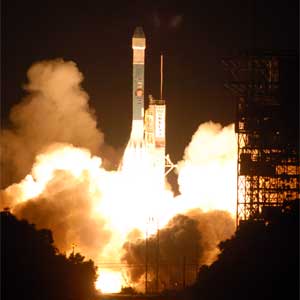 |
| Dr. Tom Duck watches the NASA broadcast in ±«Óătv's D-Drive lab. (Ryan McNutt photo) |
ĂWeĂre off,â announced a jubilant Tom Duck with his little boy on his lap. ±«Óătv 30 people gathered to watch the early-morning launch on five large screens in the D-Drive Lab in ±«ÓătvĂs Computer Science Building.
ĂItĂs over the launch pad now Ă go, go, go!â continued Dr. Duck, his eyes wide, his face lit up. ĂItĂs going on its way nowĂ fantastic!â
The powerful three-stage rocket with nine solid rocket motors lifted off at 6:26 a.m. Atlantic time. Not long later, the Phoenix spacecraft separated from the Delta II rocket and ground controllers at NASA's Deep Space Network acquired its signal and began assessing its health.
SEE VIDEO: Phoenix headed to Mars. (NASA TV)
Phoenix is expected to reach Mars in 10 months, a 680-million kilometre journey through space.
The next big hurdle is the landing. Phoenix follows in the flight path of the Mars Polar Lander, which crashed in late 1999 when it attempted to touch down at the Martian south pole.
Entry into the Martian atmosphere is a crucial stage of the mission. Various factors Ă such as the density of the Martian atmosphere, a sandstorm, an outcrop of rock, the spacecraft's speed, a faulty trajectory, a lack of fuel, or an electronic glitch Ă could imperil the mission.
 |
| A Delta II rocket lights up the sky over the Kennedy Space Centre in Cape Canaveral, Florida. (NASA) |
ĂWeĂre relieved now, but in 10 months the anxiety will build again,â says research associate Cameron Dickinson. If all goes to plan, the Phoenix will land on Mars cushioned by landing thrusters.Â
Once safely on the planet, researchers will be able to activate the instruments on board and begin experiments in the search for water on the Red Planet.
PhoenixĂs assignment is to dig through the Martian soil and ice in the arctic region and use its onboard scientific instruments to analyze the samples it retrieves. The Canadian contribution to the mission is a weather station, including a pressure sensor, three temperature sensors and the lidar, developed with the input and expertise of ±«Óătv researchers. The lidar will determine the position, structure and optical properties of clouds, fog and dust in the lower atmosphere. Meteorological instruments will gauge pressure and temperature to establish the climatic cycles on the northern plains of Mars.
ĂEverything had to go right and it did,â said a visibly relieved Dr. Duck, who confessed his hands were still shaking a half-hour after liftoff. HeĂs the co-investigator for the weather station aboard Phoenix and associate professor in ±«ÓătvĂs Department of Physics and Atmospheric Science. ĂWeĂre confident it will survive the trip, the landing and the harsh conditions on Mars.â
With Phoenix now hurdling towards Mars, there is still much to be done. Dr. Dickinson says they will be able to monitor the health of the instruments onboard from mission control in Tucson, Arizona, where theyĂll also be conducting training drills using duplicates of instruments aboard the Phoenix.
And, in November, Drs. Duck and Dickinson travel to AustraliaĂs red desert near Ayers Rock this fall, to see how dust behaves in the atmosphere.
